Moore
Average nut quality of test trees.
| # Nuts / lb. | % Kernel | Kernel quality breakdown | Specific gravity | ||
| % Fancy | % Standard | % Amber | |||
| 90 | 45% | 9% | 28% | 7% | .72 |
History
'Moore' originated in Monticello, FL. It was jointly promoted by several nurserymen in the Monticello area. Initially 'Moore' was popular in southwest Georgia and north Florida. It has been used in breeding and is the female parent of 'Barton'. (Sparks, 1992).
Comments
*Note: This is an older cultivar planted in the Old Variety Test at the Tifton Campus. Trees were planted decades ago when care was very different than it is now, and trees received much less care, so production data will reflect this fact. Trees began receiving insecticides in 1962, fungicides in 1970, nitrogen in 1962, and drip irrigation in 1975. The data for this cultivar was collected by several individuals, but the bulk of the data and the comments are from my predecessor Dr. Ray Worley. This information was originally published here: Worley and Mullinix, 1997.
This is another cultivar frequently found in old plantings. It has few redeeming characteristics. The nut size is too small; kernel quality is poor; percentage kernel is low (45%); the nut is poorly filled; the tree overloads, causing shuck decline problems; and it is highly susceptible to scab. As you might guess, it's not a recommended cultivar.
Production record of test trees beginning in year planted
'Moore' production from the Old Variety Test. Each colored line represents the yearly production in pounds of nuts from an individual tree beginning the year planted.
Alternate Bearing Intensity* = 0.70
*Computed from mature trees using data from years after trees began receiving fertilizer and pesticide sprays.



